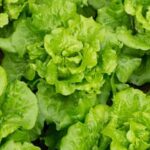The popularity of gardening Chinese vegetables has been steadily increasing in recent years. Home gardeners are discovering the beautiful and bountiful world of Chinese vegetables, incorporating them into their gardens for both their unique flavors and nutritional value. These vegetables not only add diversity to a garden but also provide an array of health benefits.
Chinese vegetables offer a wide variety of tastes and textures that can enhance any dish. From the crispness of bok choy to the earthy flavor of daikon radishes, these vegetables bring a whole new dimension to home cooking. Furthermore, they are packed with essential vitamins, minerals, and antioxidants that contribute to overall well-being.
As interest in Chinese cuisine grows, so does the desire to grow these authentic ingredients at home. By adding Chinese vegetables to their gardens, individuals have access to fresh produce with distinct flavors that cannot be replicated in store-bought varieties. Gardening Chinese vegetables provides an opportunity for experimentation and exploration in the kitchen while also promoting self-sustainability and healthy living.
Whether you’re a seasoned gardener looking for new culinary adventures or a beginner interested in exploring different vegetable varieties, gardening Chinese vegetables is sure to bring joy and satisfaction. In this article, we will guide you through every step of cultivating your own Chinese vegetable garden, from selecting the right varieties for your climate to harvesting and storing your bountiful crop. Get ready to embark on a flavorful journey through the world of gardening Chinese vegetables.
Importance of Choosing the Right Chinese Vegetable Varieties
Choosing the right Chinese vegetable varieties is crucial for successful gardening. Different Chinese vegetable varieties thrive in specific climates and soil conditions, so it’s important to select ones that are suitable for your region. By understanding the unique needs of each variety, gardeners can maximize their chances of a bountiful harvest.
When choosing Chinese vegetable varieties, consider factors such as temperature, sunlight requirements, and soil type. Some Chinese vegetables prefer cooler temperatures and can withstand frost, while others thrive in warmer weather. Understanding the climate of your region will help you select the appropriate varieties.
Sunlight is another important consideration. Most Chinese vegetables require full sun to grow and produce a good yield. Before planting, assess your garden’s sun exposure and ensure that there are no shade or obstruction issues that could limit sunlight access to your plants.
Soil type also plays a role in the success of your Chinese vegetable garden. Some varieties prefer loamy soil with good drainage, while others tolerate heavier soils with higher clay content. Conduct a soil test to determine its pH level and nutrient content, which will help you choose the right Chinese vegetable varieties for your soil type.
Here are some popular Chinese vegetable varieties suitable for different regions:
- Bok Choy: This leafy green vegetable is versatile and can be grown in both cool and warm climates.
- Napa Cabbage: Ideal for cooler regions, this cabbage variety has mild flavors and requires ample sunlight.
- Yardlong Beans: These beans thrive in warm climates and need support from trellises or stakes as they grow tall.
- Chinese Kale (Kai-lan): Similar to broccoli but with more tender stems and leaves, this vegetable prefers cooler temperatures.
- Luffa Gourd: This climbing vine prefers hot summers and needs a sturdy trellis for support.
By selecting the right Chinese vegetable varieties based on regional climate and soil conditions, gardeners can ensure successful cultivation of these delicious and nutritious plants. Experimenting with different varieties can also add diversity to your garden and expand your culinary options.
Preparing the Garden for Chinese Vegetable Cultivation
When it comes to growing Chinese vegetables in your garden, proper preparation is key to ensuring successful cultivation. By taking the time to prepare your garden correctly, you can create an ideal environment for these vegetables to thrive. In this section, we will discuss the essential steps for preparing the soil and providing the necessary conditions for Chinese vegetable plants.
One of the first steps in preparing your garden for Chinese vegetable cultivation is testing the pH levels of your soil. Most Chinese vegetables prefer a slightly acidic soil with a pH range between 6.0 and 7.0.
You can easily test the pH levels using a soil testing kit available at gardening centers or through online retailers. If your soil’s pH is outside the optimal range, you can adjust it by adding organic matter like compost or sulfur to lower the pH, or limestone to raise it.
In addition to pH levels, Chinese vegetables also require well-draining soil with good fertility. Before planting, it’s advisable to amend your garden soil with compost or well-rotted manure to improve its fertility and moisture-retention capabilities. This will provide a nutrient-rich environment that allows Chinese vegetable plants to grow healthy and vigorous roots. It’s important to work these amendments into the top few inches of soil before planting.
| Essential Steps for Preparing the Garden |
|---|
| Test the pH levels of your soil and adjust if needed |
| Amend your garden soil with compost or well-rotted manure |
| Create well-draining soil with good fertility |
Planting Chinese Vegetables
When it comes to planting Chinese vegetables, starting from seeds is a cost-effective and rewarding way to go. Whether you choose to start your seeds indoors or directly in the garden, proper planning and care during this crucial stage will set the foundation for a thriving vegetable garden. In this section, we will provide guidance on planting Chinese vegetables from seeds to seedlings.
Choosing Quality Seeds
Before beginning the planting process, it’s important to select high-quality seeds. Look for reputable seed companies that offer a wide variety of Chinese vegetable seeds. Opt for organic or heirloom varieties whenever possible, as they often have better flavor and nutritional value. Additionally, ensure that the seeds are fresh by checking the expiration date on the packet.
Starting Seeds Indoors
Starting your Chinese vegetable seeds indoors allows for better control over temperature and moisture levels, resulting in higher germination rates. Begin by filling seed trays or pots with a well-draining soilless mix. Place one or two seeds per cell or pot, following the recommended sowing depth specified on the seed packet. Keep the soil evenly moist but not saturated, misting with water as needed.
To promote germination, maintain a consistent temperature between 70°F and 80°F (21°C – 27°C). Utilize grow lights or place trays near a sunny window to provide adequate light for at least 10-12 hours per day. Once the seedlings have developed their first true leaves (typically after 2-4 weeks), thin out weaker seedlings if multiple sprouts emerged in each cell/pot.
Direct Sowing in the Garden
Direct sowing in the garden is suitable for hardy Chinese vegetables that can tolerate cooler temperatures and are grown during the spring or fall seasons. Before sowing, prepare your garden beds by loosening and amending the soil with compost. Follow the instructions on the seed packet for spacing between plants and rows, as it can vary depending on the vegetable.
Sow the seeds to the recommended depth, gently patting them down into the soil. Ensure that they are evenly spaced and covered with soil to promote germination. Water the bed thoroughly after sowing, keeping the soil moist while waiting for seedlings to emerge. As they grow, thin out excess seedlings, allowing sufficient space for each plant to develop properly.
Taking care during the planting stage is vital for successful Chinese vegetable cultivation. By selecting quality seeds and providing optimal conditions for germination and growth, you will be on your way to a bountiful harvest of homegrown Chinese vegetables. Now let’s move on to essential care and maintenance for your growing plants in the next section.
Essential Care and Maintenance for Chinese Vegetable Plants
Chinese vegetable plants require proper care and maintenance to ensure healthy growth and maximize their potential. Here are some essential tips to keep in mind when caring for your Chinese vegetable plants:
- Watering techniques: Adequate watering is crucial for the health of Chinese vegetable plants. Water the plants deeply and evenly, making sure to reach the root zone without causing waterlogging. In general, Chinese vegetables appreciate consistent moisture but avoid overwatering, which can lead to diseases like root rot.
- Weeding and fertilization: Regular weeding is important to keep unwanted weeds from competing with the Chinese vegetable plants for nutrients and sunlight. Additionally, fertilize your Chinese vegetables periodically with organic matter or a balanced fertilizer to provide them with essential nutrients. Mulching can also help suppress weeds and conserve soil moisture.
- Support structures: Some varieties of Chinese vegetables, such as yard-long beans or climbing spinach, may require support structures like trellises or stakes. These structures help support the plant’s growth and prevent damage from strong winds or heavy fruits.
- Pest control: Like any other garden plant, Chinese vegetables can be susceptible to pests. Common pests that may affect Chinese vegetable plants include aphids, cabbage worms, slugs, and flea beetles. Use natural remedies such as neem oil or insecticidal soap to control these pests without harming beneficial insects.
- Disease prevention: There are various diseases that can affect Chinese vegetable plants, including powdery mildew, bacterial leaf spot, and fungal infections. To prevent these diseases, practice good sanitation by removing diseased plant parts promptly. Avoid overhead watering as it can promote foliage diseases, and ensure proper spacing between your plants to improve air circulation.
By following these care and maintenance practices, you can nurture your Chinese vegetable plants and enjoy a bountiful harvest. Remember to observe your plants regularly for any signs of distress or pest infestation, as early intervention is key to preventing damage. With proper care, your Chinese vegetable plants will thrive and reward you with delicious and nutritious produce.
Dealing with Common Pests and Diseases in Chinese Vegetables
Chinese vegetables are known for their resilience and ability to thrive in various garden conditions. However, like any other plants, they are susceptible to pests and diseases that can hinder their growth and productivity. In this section, we will discuss some of the common pests that often affect Chinese vegetables and provide natural remedies to control them. We will also provide guidance on preventing and managing diseases that can harm Chinese vegetable plants.
Common Pests
- Aphids: These small insects feed on the sap of Chinese vegetable plants, causing stunted growth and distorted leaves. To control aphids, you can introduce ladybugs or lacewings into your garden as natural predators. Alternatively, you can create a homemade neem oil spray by mixing neem oil with water and a few drops of dish soap. Apply this solution to affected plants.
- Cabbage Worms: Cabbage worms are common pests that often attack leafy greens such as bok choy or Chinese cabbage. Handpicking the worms off the leaves is an effective method if the infestation is small. You can also use floating row covers to prevent these pests from reaching your crops.
Common Diseases
- Downy Mildew: This fungal disease thrives in cool and moist conditions, causing yellow spots on the upper side of leaves while leaving a fuzzy-like growth underneath. To prevent downy mildew, space your plants properly to improve air circulation, avoid overhead watering, and remove affected plant parts promptly.
- Powdery Mildew: Powdery mildew appears as white or grayish patches on leaves of Chinese vegetables like gourds or winter melons. Provide adequate spacing between plants to allow better air flow around the foliage. Regularly prune overcrowded areas to minimize humidity buildup and remove infected leaves immediately.
By taking preventive measures such as providing proper spacing, practicing good garden hygiene, and implementing natural pest control methods, you can minimize the occurrence of pests and diseases in your Chinese vegetable garden. Regularly inspect your plants for signs of infestation or disease and take immediate action to protect your crops. With proper care and attention, you can enjoy a thriving garden filled with healthy and nutritious Chinese vegetables.
Harvesting and Storing Chinese Vegetables
When it comes to harvesting and storing Chinese vegetables, timing is crucial. Each vegetable has its own signs of maturity, indicating the best time to harvest for optimum flavor and nutritional value. Proper handling and storage techniques are also essential to extend the shelf life and maintain the freshness of these homegrown delicacies.
To determine if Chinese vegetables are ready for harvest, pay attention to visual cues such as size, color, and texture. For example, leafy greens like bok choy and Chinese spinach should be harvested when they have reached a desired size but before they start to bolt or develop a bitter taste.
The leaves should be crisp and vibrant in color. Root vegetables like daikon radish or Chinese yam can be harvested once they have reached their mature size, usually indicated by a full-sized bulb or tuber that is firm to touch.
After harvesting your Chinese vegetables, proper cleaning is necessary to remove any dirt or debris. Gently rinse them with cool water ensuring not to bruise or damage the delicate leaves or stems. It’s important to dry them thoroughly before storage to prevent rotting or mold growth. A salad spinner or clean kitchen towels can be used for this purpose.
Storage conditions will vary for different types of Chinese vegetables. Leafy greens like Shanghai pak choi and Chinese cabbage can be stored in the refrigerator for up to one week in a plastic bag with holes punched in it for airflow. Other vegetables like snow peas and Chinese long beans should be kept in perforated plastic bags as well but stored at a slightly higher humidity level, preferably in the crisper drawer of the fridge.
To track the storage lifespan of each variety of Chinese vegetable you have grown, consider maintaining a garden journal where you note down the date of harvest and expected shelf life based on research or experience.
Overall, harvesting and storing Chinese vegetables appropriately ensures you get maximum flavor from your garden-to-table experience. With the right timing and storage conditions, you can savor the freshness and health benefits of these flavorful Asian greens in your home cooking.
Harvesting and Storing Chinese Vegetables Data
| Chinese Vegetable | Timing for Harvest | Cleaning | Storage Conditions |
|---|---|---|---|
| Bok Choy | When leaves are at desired size, before bolting or bitterness develops | Gently rinse with cool water, dry thoroughly | In a plastic bag with holes punched in it in the crisper drawer of the fridge, up to 1 week |
| Chinese Spinach | When leaves are crisp and vibrant in color | Gently rinse with cool water, dry thoroughly | In a plastic bag with holes punched in it in the crisper drawer of the fridge, up to 1 week |
Popular Recipes and Cooking Ideas for Chinese Vegetables
When it comes to gardening Chinese vegetables, the rewards go beyond just growing your own produce. One of the most enjoyable aspects is undoubtedly being able to enjoy the unique flavors of these vegetables in various delicious recipes. With their distinct tastes and textures, Chinese vegetables can elevate any dish and add a burst of flavor to your meals. Here are some popular recipes and cooking ideas for Chinese vegetables that you can try:
- Stir-frying: Stir-frying is a classic and versatile cooking method commonly used in Chinese cuisine. It involves quickly cooking bite-sized pieces of vegetables in a hot skillet or wok with a small amount of oil. Chinese leafy greens like bok choy, gai lan (Chinese broccoli), and yu choy are perfect for stir-frying due to their tender leaves and stalks. Add some garlic, ginger, soy sauce, or oyster sauce for extra flavor.
- Steaming: Steaming is an excellent way to preserve the natural freshness and crunchiness of Chinese vegetables while showcasing their vibrant colors. Vegetables such as baby bok choy, Shanghai bok choy, and napa cabbage are particularly suited for steaming. Simply arrange the washed and trimmed vegetables in a steamer basket over boiling water and steam until tender-crisp. Serve with a drizzle of soy sauce or a sprinkle of sesame oil.
- Soup: Chinese vegetable soups are comforting, nutritious, and incredibly satisfying. Most varieties of Chinese leafy greens can be used in soups, including mustard greens (gai choy), water spinach (ong choy), and amaranth greens (hinn choy). Combine them with ingredients like tofu, mushrooms, carrots, and chicken or vegetable broth for a nourishing bowl of soup that’s both hearty and healthy.
- Pickling: Pickling is a great way to prolong the shelf life of your harvested Chinese vegetables while adding tangy and savory flavors to your dishes. Daikon radish, Chinese turnip (lo bok), and Chinese mustard greens (gai choy) can be pickled to create delightful condiments that complement a wide range of dishes. Experiment with different pickling liquids like rice vinegar, soy sauce, and sugar to achieve your desired taste.
These are just a few examples of the many ways you can enjoy the flavors of your homegrown Chinese vegetables in various dishes. Don’t be afraid to get creative in the kitchen and try out different recipes that make the most of each vegetable’s unique taste. Gardening Chinese vegetables not only allows you to have fresh produce at your fingertips but also opens up a world of culinary possibilities right in your own kitchen.
Conclusion
In conclusion, cultivating a Chinese vegetable garden is not only a rewarding experience but also provides numerous benefits. The unique flavors and nutritional value of Chinese vegetables make them a popular choice for home gardeners. Through careful selection of the right Chinese vegetable varieties, proper soil preparation, and providing adequate care and maintenance, gardeners can ensure successful cultivation.
By taking preventive measures against common pests and diseases and using proper harvesting and storage techniques, the freshness of harvested Chinese vegetables can be preserved. Additionally, cooking with homegrown Chinese vegetables opens up a world of delicious and authentic recipes.
The joy of gardening Chinese vegetables lies in the satisfaction of growing your own food that is both flavorful and healthy. It offers a sense of accomplishment to witness the growth from seeds to harvestable plants.
Furthermore, being able to enjoy the unique tastes and textures that these vegetables have to offer is truly delightful. Whether it’s stir-frying bok choy in garlic sauce or making dumplings filled with freshly harvested chives, each dish becomes an appreciation for the hard work put into cultivating these ingredients.
Gardening Chinese vegetables also allows you to take control over what goes into your food. You have the power to choose organic methods and avoid harmful chemicals often found in store-bought produce. Moreover, growing your own Chinese vegetables can save you money in the long run as grocery bills decrease when you no longer need to purchase these items.
Frequently Asked Questions
What is the easiest Chinese vegetable to grow?
One of the easiest Chinese vegetables to grow is bok choy, also known as Chinese cabbage. Bok choy has a relatively short growing season and can adapt to various climates, making it suitable for beginner gardeners. This leafy green vegetable thrives in well-drained soil and requires consistent watering.
It can be grown from seeds or transplanted seedlings and is usually ready for harvest within 6-8 weeks. Its mild and slightly sweet flavor makes bok choy a versatile ingredient in many Chinese dishes.
What are 3 typical Chinese vegetables?
Three typical Chinese vegetables commonly found in traditional Chinese cuisine are gai lan (Chinese broccoli), dou miao (pea shoots), and bai cai (napa cabbage). Gai lan has thick stalks with dark green leaves and a slightly bitter taste, often stir-fried or blanched and served with oyster sauce or garlic.
Dou miao, the tender young shoots of pea plants, have a delicate flavor and crisp texture that are highly sought after in stir-fries and soups. Bai cai, also known as Chinese cabbage or Napa cabbage, has tightly packed elongated leaves with a mild, sweet flavor perfect for stir-fries or pickling.
What are traditional Chinese veggies?
Traditional Chinese veggies encompass a wide variety of vegetables that have been commonly used in Chinese cooking for centuries. Some examples include kong xin cai (water spinach), jiu cai (Chinese chives), and huang gua (ridged gourd). Kong xin cai is a popular leafy green vegetable with hollow stems that impart a subtle sweetness when cooked quickly, often stir-fried with garlic or fermented bean curd.
Jiu cai adds a distinct flavor to dishes with its pungent aroma reminiscent of onion or garlic; it is frequently used in dumplings or savory pancakes. Huang gua belongs to the cucurbit family like zucchini but has a firm, ridged exterior. It is commonly used in Chinese stir-fries, soups, or pickled as a condiment.

If you’re looking to get into vegetable gardening, or are just looking for some tips on how to make your current garden better, then you’ve come to the right place! My name is Ethel and I have been gardening for years. In this blog, I’m going to share with you some of my best tips on how to create a successful vegetable garden.





